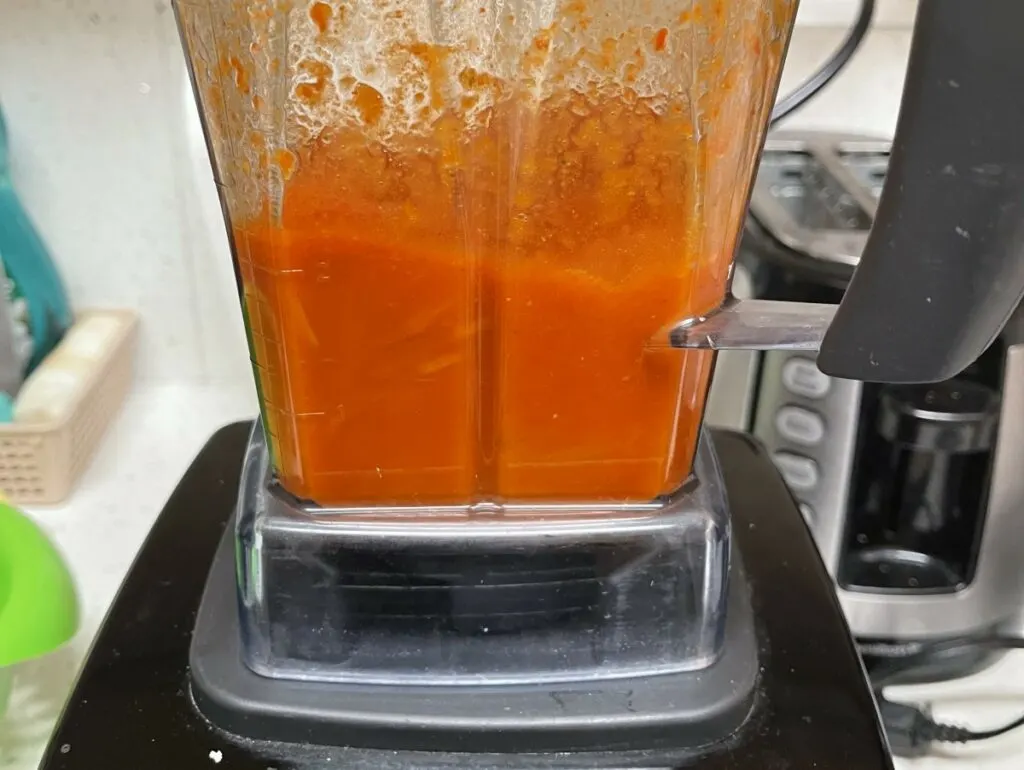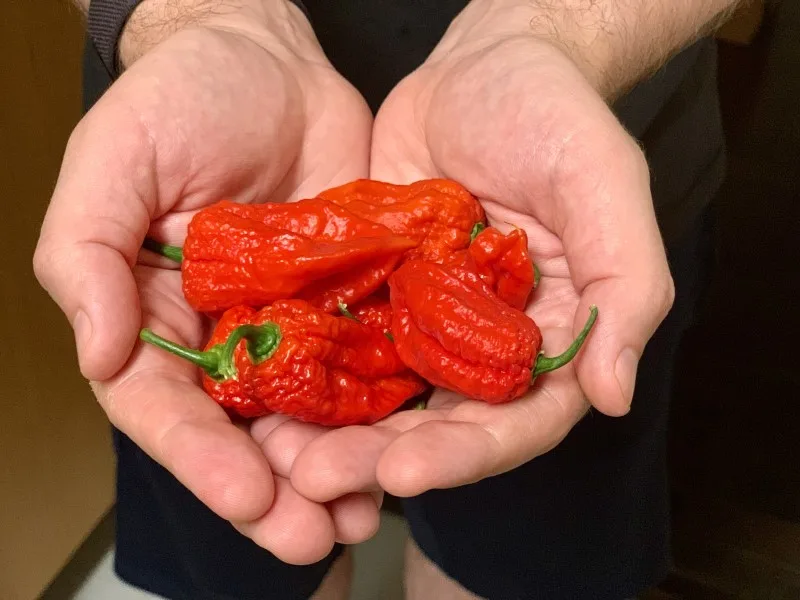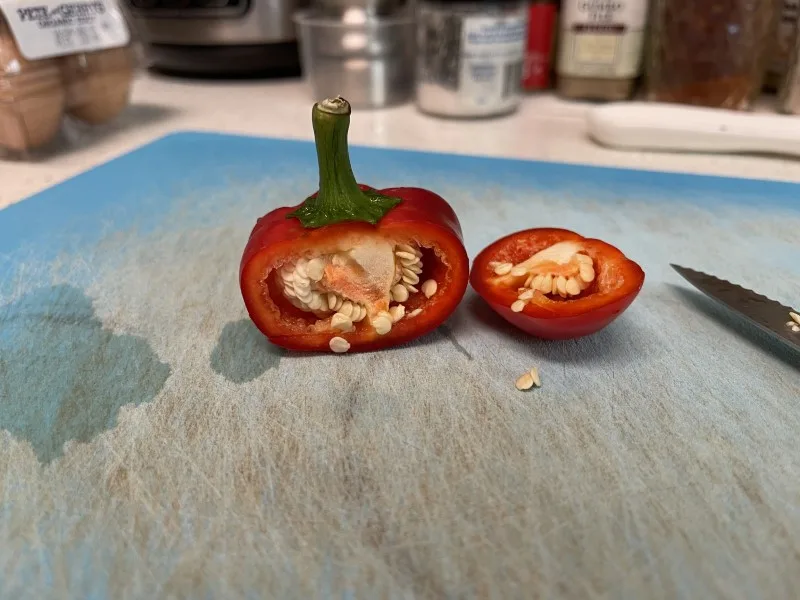As an Amazon Associate, I earn from qualifying purchases.
Many spicy food enthusiasts love to make their own signature hot sauce at home, and they may have all asked themselves: how do I make this hot sauce even hotter? If you are interested in spicing up your hot sauce to extreme levels, there are a few easy things that you can try.
To make your homemade hot sauce even hotter, add fresh or powdered spicy peppers such as Cayenne, Ghost, or Scorpion peppers—or set your world aflame with a Carolina Reaper! You can try adding the pepper seeds and placenta or reducing the sauce to bring out the capsaicin.
This article will detail the most popular hot peppers you can add to your sauce to make it even spicier. You’ll also learn a few things you can do during the cooking process to bring out the heat in the peppers you already have.

1. Use Hotter Chili Peppers as Your Base
One way, and the frankly the best way, to spice up your hot sauce is to add fresh chili peppers that are hotter than the base of your sauce.
Every hot sauce recipe you come across will be a little different, but they all have some pepper variety as their base. However, one perk of making your sauce hotter—is changing the recipe and tweaking the spice level to your liking.
You can do this by changing the base to a hotter pepper than the recipe calls for or using more than one pepper as the base and including a hotter pepper.
The easiest way to find the hotter chili that you want to use is by looking at the Scoville scale. For example, Jalapeños are a common pepper that could be the base of your sauce. However, Jalapeños are only about 8,000 SHUs.
If you want to spice up your hot sauce, you can either use a hotter pepper, such as a Tabasco pepper (30,000 – 50,000 SHUs), as the base of your sauce or combine the hotter pepper with the base.
Depending on how hot you want to make your hot sauce, you can choose from a spectrum of peppers, from Tabasco to Ghost or Carolina Reaper peppers. Just look at the Scoville units and use that as your guide to add the right amount of spice to your sauce.

2. Add Chili Powders Made From Hot Pepper Varieties
An easy way to make your hot sauce even hotter is to add chili powder from hot pepper varieties. This is also a good way to add that Ghost pepper or Carolina Reaper pepper flavor and heat to your sauce, even if you are unable to get a hold of that fresh pepper.
Each pepper variety has a concentration of capsaicinoids which determines how much heat is in each pepper. Scoville Heat Units are a common way to report this concentration and allow pepper comparison using the Scoville Scale. For example, a pepper with 10,000 SHUs will taste hotter than a pepper with only 1,000 SHUs.
To give you an idea of the Scoville scale, here are a few common peppers and their Scoville Units:
- Bell pepper: 0 Scoville units
- Banana pepper: 500 Scoville units
- Jalapeño pepper: 2,000–8,000 Scoville units
- Tabasco pepper: 30,000–50,000 Scoville units
- Habanero pepper: 100,000–350,000 Scoville units
To spice up your homemade hot sauce, add powder from a chili known for its heat. Here are a few examples of hot pepper powders that you can use to spice up your sauce:
Add Cayenne Pepper Chili Powder for More Heat
If your hot sauce is too mild for your taste, try adding some Cayenne pepper powder. Cayenne peppers typically range between 30,000 to 50,000 SHUs, making them far spicier than Jalapeños, but not extremely hot like some other peppers.
Adding Cayenne pepper is an excellent option for someone who wants to add an extra kick to their sauce but isn’t trying to go to extreme levels of heat.
The pepper itself is thin and roughly two to five inches long. It is also bright red and related to Jalapeños and Bell peppers. This pepper is extremely popular, and anyone who cooks regularly likely already has Cayenne pepper powder in their spice cabinet.
Cayenne pepper is a popular spice and can be found in any grocery store if you don’t already have it at home. You can also order it online, such as this small container of Simply Organic Cayenne Pepper, sold on Amazon.com. This product delivers exceptional flavor—and it’s 100% organic too!
If you aren’t a fan of Cayenne, you can also try adding Tabasco which has a similar Scoville rating.
Add Ghost Pepper Chili Powder to Make Your Sauce Spicier
You can add Ghost pepper powder to your recipe for those brave enough to go hotter.
The Ghost pepper held the title “Hottest Pepper in the World” in 2007 and came in at 1 million Scoville units (average 600,000 SHUs). To give you an idea of how hot this pepper is, it is up to three times hotter than your typical Habanero Pepper.
When people discovered this pepper it took the internet by storm, and everyone was trying to eat the Ghost pepper in what was called the “Hot Pepper Challenge.”
Also called the Bhut Jolokia, the Ghost pepper is only about 3 inches long and has very wrinkly skin. Depending on their ripeness, they can come in red, orange, or yellow.
The Ghost pepper is less common than the Cayenne pepper, and you’ll have to look in specialty grocery stores to find the pepper during harvest season, which is late summer to early fall. Take caution if you plan on handling the pepper, as touching a pepper this hot with your bare hands can cause chili burn, and you don’t want to get that oil near your eyes!
You can buy Ghost pepper in powder form year-round. If you don’t have a specialty store near you, you can buy Ghost pepper powder online.
The Kiva Store sells Fair Trade 100% Ghost Chili Pepper Powder on Amazon.com. This product offers pure Ghost chili pepper that the makers smoke to give a delicious—and blistering—flavor profile.
Use Scorpion Pepper Chili Powder for a Kick
In 2012, a new pepper was named the “Hottest Pepper in the World,” the Scorpion pepper. The Scorpion pepper ranges between 1,200,000 to 2,000,000 Scoville units, nearly twice as hot as the previously mentioned Ghost pepper.
The Scorpion pepper is short and stocky, resembling the shape of a Habanero or a Scotch Bonnet pepper. The skin of this pepper is smooth and glossy, but it has distinct grooves all over it. Depending on their ripeness, you can find them in green, yellow, or red.
However, the riper it is, the spicier it will be. Scorpion peppers are the most popular among heat lovers.
Like the Ghost pepper, the Scorpion pepper is dangerous to handle, and you can only find it in specialty stores. You should always use gloves when touching the pepper, and be sure not to touch your eyes.
You can purchase the pepper from online retailers, such as Red Tail on Amazon.com, in dried form, like this Whole Trinidad Scorpion Peppers, which offer you a blistering 1,200,000 Scoville Heat Units of extreme heat.
Alternatively, opt for the powdered option, such as the Red-Tail Moruga Scorpion Powder, which also hits the fire level of 1,200,000 SHUs.
Carolina Reaper Chili Powder for The Hottest of Hot Sauces
If you want to get your hot sauce as hot as possible, you can use Carolina Reaper chili powder.
This pepper is not for the faint of heart. According to the Guinness World Records, the Carolina Reaper pepper is the hottest chili in the world. This pepper sits at a whopping 1,600,000 to 2,200,000 Scoville units.
The Carolina Reaper is a relatively small chili, measuring one to two inches wide and two to three inches long. It is also red when it is ripe and has a pointy bottom.
The heat of this chili sneaks up on you. It has an initial fruity taste before knocking you over with unimaginable heat! Some people have said that eating this pepper is like swallowing lava, so if that is the kind of heat you are after, you’ve found the right pepper!
Some people feel lightheaded and massive heartburn-like pain. After about 10 minutes, that part is over, but people forget that your insides also react to the spiciness that comes from these peppers. It is common for people to report very painful stomach cramps hours later, and some people even report feeling nauseous.
If you are interested in adding this chili to your hot sauce, take great caution not to overdo it. A little will go a long way in your recipe. And just like the other peppers on this list, wear protective gloves when handling the pepper.
Wicked Reaper Wicked Tickle sells Carolina Reaper Chili Pepper Powder (available on Amazon. com), offering you a volcanic 2,000,000 Scoville Heat Units! You can also check local farms and specialty stores for this pepper if you’d prefer to dry and powder it yourself.
The most recent Carolina Reaper hot sauce I made consisted of roasted onion and garlic, along with 2 rehydrated dried Carolina Reaper peppers, a red Bell pepper, and apple cider vinegar. I added them all to a blender and blended the ingredients until smooth. I made sure to add a few pinches of salt to get the flavor just right.

3. Add Chili Seeds and Pepper Placentas to Your Sauce
While some people may think that the hottest part of the pepper is the flesh, it is the placenta and the area around the seeds where the pepper stores its heat.
When you cut open a pepper, the middle of it around the seeds looks like veins or ribs and is white or yellowish. You’ll also see that the seeds are held to the top of the pepper by the pepper placenta. These areas are where the pepper stores capsaicin, the chemical that makes a pepper hot.
Most people will remove the seeds and placenta when preparing peppers for recipes. But doing this also eliminates a lot of the heat!
If you’re trying to spice up your homemade hot sauce recipe without adding other pepper varieties, try leaving the placenta and seeds in the sauce. This method will add extra capsaicin and give the sauce some more heat without you buying additional ingredients.
One thing to remember is that adding these parts of the pepper may alter the consistency of your sauce. The veins and placenta are more robust than the pepper flesh, and the seeds will give a more grainy texture. You can combat this by blending the sauce to your desired consistency if you don’t want a chunky hot sauce.
4. Reduce the Hot Sauce in a Saucepan
Another easy way to add extra spice to your sauce without adding more ingredients is to reduce the sauce in a pan. When you reduce something while cooking, you bring out more flavor and thicken the sauce.
In the case of your homemade hot sauce, reducing the sauce in a pan will further break down the peppers and release more flavor into your sauce. Additionally, this will increase the capsaicin release from the peppers, releasing more heat into your sauce.
Sauce reduction is an excellent method to add more flavor and heat to your sauce while cooking, without buying more peppers. It may take a little bit more of your time, but it will be worth it when you have a delicious and spicy sauce.
5. Use Pepper Extract to Add Concentrated Capsaicin
Adding pepper extract to your recipe is one final way to make your hot sauce even hotter. Pepper extracts are concentrated forms of capsaicin from scorching peppers like the ones we discussed earlier in this article, like the Ghost or Carolina Reaper pepper.
An extract will come as an oil, and you may add them to many dishes, including scorching hot sauces.
While oil may not look intimidating, use these extracts cautiously as they are extremely hot and dangerous to touch. Since this extract comes from the hottest peppers in the world, it can cause severe pain to your skin, eyes, or mouth if you come into contact with them.
Use a pepper extract in your sauce sparingly if you choose to use it. Too much of this ingredient can bring your hot sauce up to dangerous heat levels and cause pain and injury if misused. It may also add an unnatural flavor to your hot sauce, that may take some time to get used to. In our experience, we have often not liked hot sauces that use extracts, because while they pack powerful heat, they often distort the flavor of the hot sauce, making it less enjoyable.
You may purchase these oil extracts online. Here are a few extract options from Amazon.com if you want to kick up the heat in your sauce:
- Sauce Crafters Direct Stores offers an 800,000 SHUextract called Satan’s Blood Chili Pepper Extract, bringing your hot sauce up to near Ghost pepper heat levels.
- Wood’s Ghost Pepper Extract comes in a two-ounce bottle with an eye dropper lid to help you add oil to your favorite recipes sparingly.
- Mad Dog 357 offers a One Million Scoville Extract in a 4 oz bottle for hot sauce lovers who want their hot sauces even hotter.
- Mad Dog 357 also offers a Six Million Scoville Extract that will bring even the spiciest sauces up many notches.
